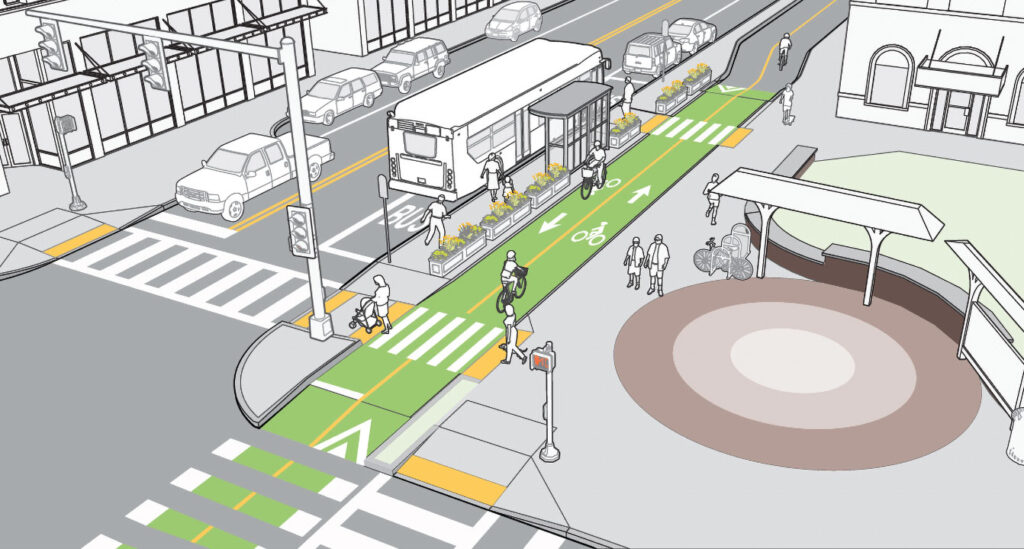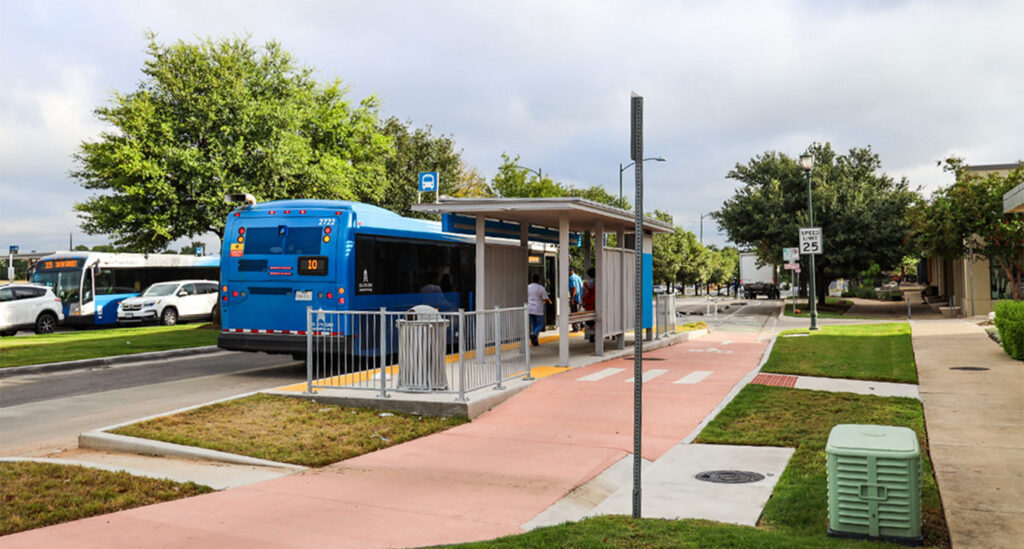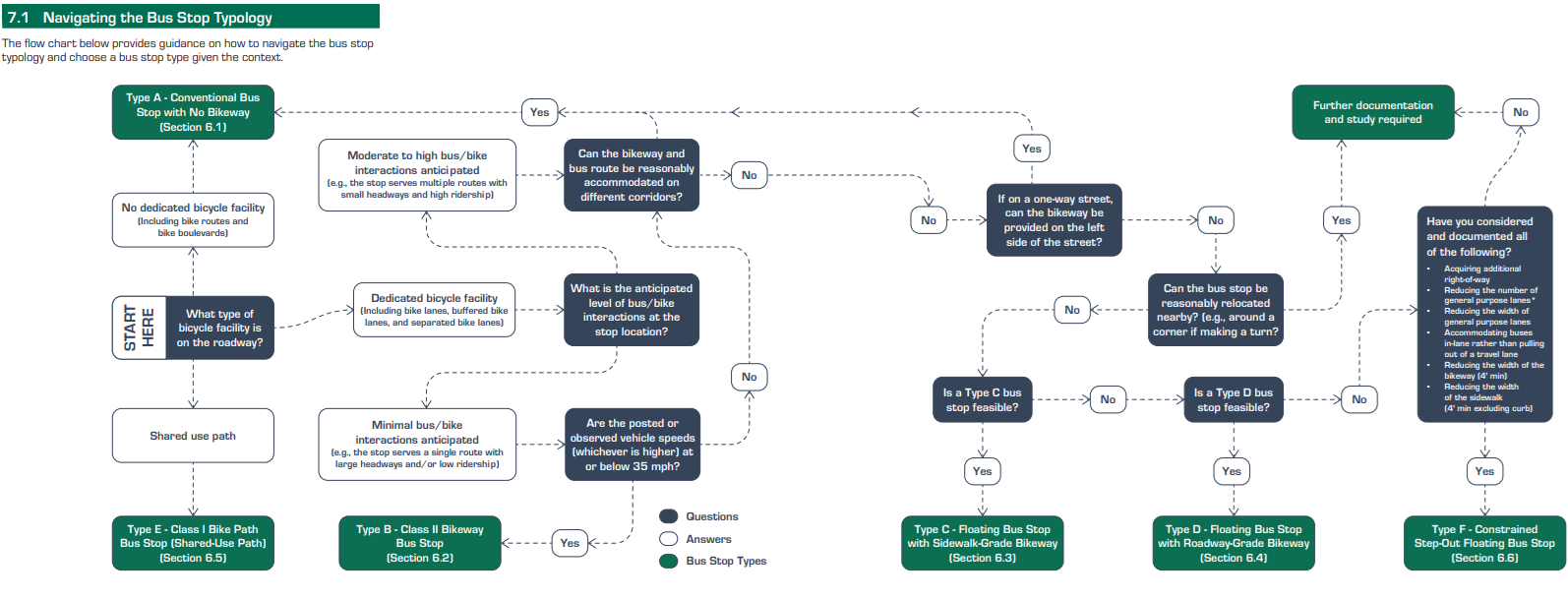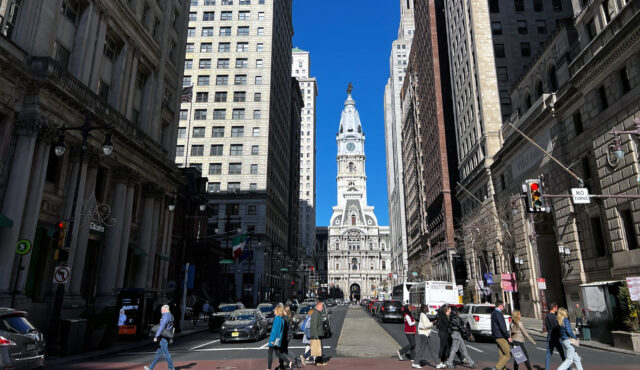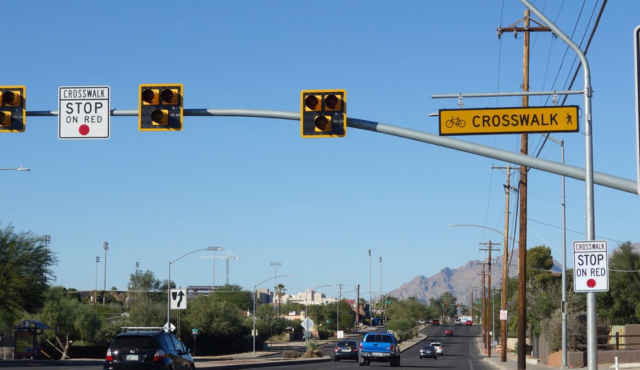This post is authored by Principal Engineer Dylan Passmore, P.Eng. and Project Engineer II Sara Rauwolf, PE.
As agencies increasingly invest in multimodal transportation, planners and designers are often tasked with integrating high-quality bikeways alongside reliable transit service. Designing corridors for both buses and bikes isn’t just about fitting elements into a cross-section; it’s about creating a seamless, conflict-free experience for all users.
Instead of treating bikeways and transit routes as separate systems, we need to think of them as overlapping networks in a system of Complete Streets and prioritize solutions that support connectivity, visibility, and accessibility for all users, especially in the places where their paths cross.
This post offers five key questions to guide your approach when designing corridors that serve both bicycles and transit.
Is a floating bus stop necessary?
Floating bus stops route the bikeway behind a bus boarding area, allowing buses to stop without crossing the bike lane. This design maintains a continuous protected bikeway and provides a clear space for people to board and alight safely.
If your project includes a two-way separated bike lane on the right side of the street along a transit route, floating bus stops aren’t optional — they’re a must. But even in other contexts, such as one-way separated or conventional bike lanes, floating bus stops are strongly recommended if any of the following conditions are present:
- A bus stop and bikeway must coincide
- High propensity of drivers to stop in the bikeway (in absence of separation)
- High-frequency and/or high-ridership transit service
- High bicycle volumes
- High speed limits (often 30+ mph)
Exact thresholds for determining when a floating bus stop is appropriate will vary by jurisdiction, but they all point to situations where conflicts between buses, bicyclists, and drivers are more likely. If you can check any of these boxes, floating bus stops should be part of the conversation.
The exact design of that floating bus stop and bikeway depends, of course, on the context. This graphic from the new AASHTO Guide for the Development of Bicycle Facilities shows the preferred scenario, including raised crossings, detectable edges, and directional indicators.
What about Constrained Design Scenarios?
As we all know, ideal designs aren’t always possible, especially on constrained corridors. Before jumping straight to difficult tradeoffs, think about ways to create additional space for the more vulnerable road users:
- Reduce travel lane widths to minimums allowed by local standards.
- Consider reducing the number of travel lanes.
- Consolidate or relocate curbside uses such as parking or loading.
- Stop buses in-lane rather than pulling out.
- Move the bus stop location. If the bus route turns, consider the feasibility of moving the bus stop around the corner to remove the bus-bike conflict.
At Toole Design, we’ve developed decision frameworks and standard details for our clients, such as the City of Austin and Alameda-Contra Costa Transit District (AC Transit). These tools not only identify potential design approaches for transit facilities adjacent to bikeways; they also include prompts to help clients ensure they are making the most of all available space. Even when space is tight, thinking holistically and creatively can unlock solutions that maintain safety and accessibility for all modes.
How do I Navigate Tradeoffs in a Constrained Scenario?
So, you’ve made all possible adjustments, but space is still tight? Navigating tradeoffs is a necessary part of the design process. While there’s not one right answer — tradeoffs will differ across jurisdictions and regions — we have developed guidance on how to handle some common tradeoffs.
How to handle constraints and tradeoffs is one of the central topics of TransLink’s Design Guide for Bus Stops Adjacent to Cycling Infrastructure, which focuses on Vancouver and broader British Columbia but contains concepts that can be applied in a wide variety of North American contexts. Toole Design also led an Accessible Design Guide for Montgomery County, Maryland, which includes floating bus stop design guidance based on extensive engagement through a pilot project study.
Anything else I should keep in mind when designing bikeways on frequent transit routes?
Whatever approach you take to a constrained space scenario, always remember to consider pedestrian needs. Any floating bus stop must include ADA-compliant continuous access routes, safe crossings, and comfortable waiting areas.
It’s also important to talk through maintenance and operations issues early in the process. Make sure equipment, such as street sweepers or snowplows, can navigate any pinch points or ramps.
Finally, be mindful of ensuring there are adequate sight lines at the bike lane crossings, especially when you have two-way bike travel or when the bus shelters have ad panels on them. Visual obstructions at these critical locations can create safety issues. Always consider how your potential designs might improve or impede visibility.
Where can I find the best and latest guidance on this topic?
While there’s no hard and fast set of numbers or quantified guidance that applies universally, the resources below offer valuable guidance and examples.
- AASHTO Guide for the Development of Bicycle Facilities
- AC Transit’s Transit-Supportive Design Guidelines
- City of Austin’s Transportation Criteria Manual Interim Standard Details
- Montgomery County Accessible Design Guide and accessible bus stop pilot project
- TransLink Design Guide for Bus Stops Adjacent to Cycling Infrastructure
By starting with the right mindset and leveraging proven tools, we can design corridors that support both excellent transit service and safe, comfortable biking. The solutions aren’t always simple, but with a thoughtful approach they’re well within reach and can provide essential connectivity and comfort for all types of road users.
